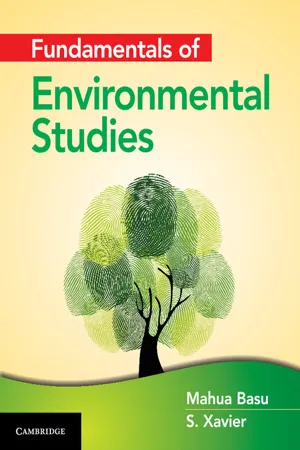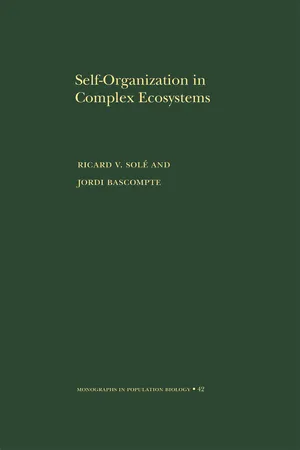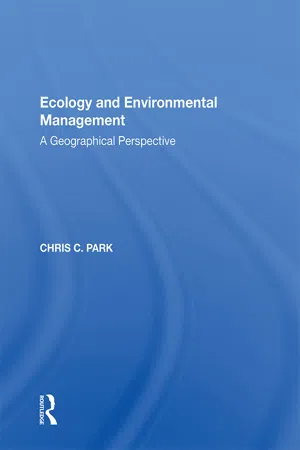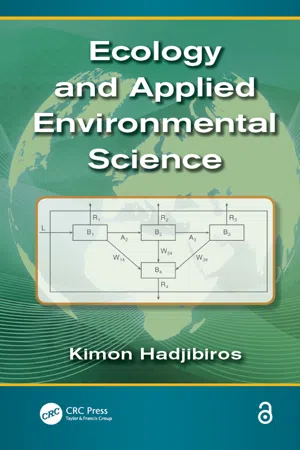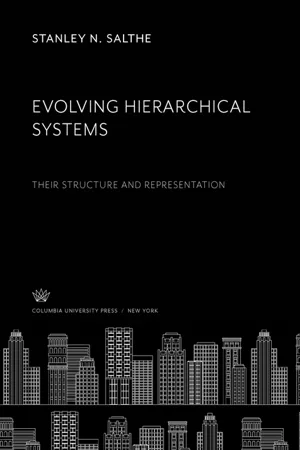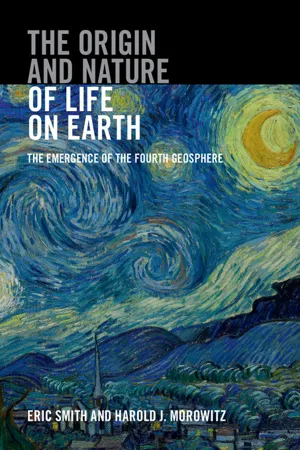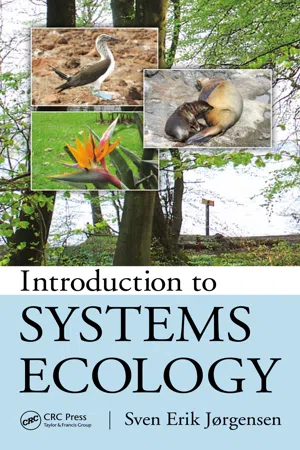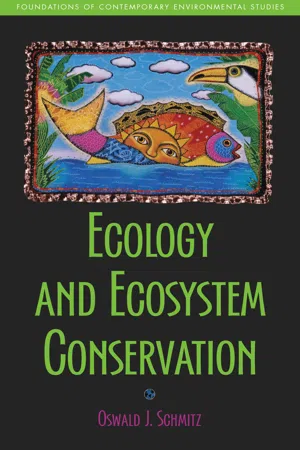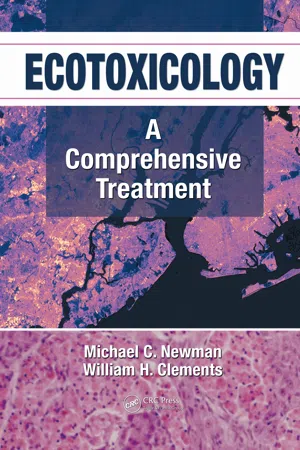Biological Sciences
Ecological Levels of Organization
Ecological levels of organization refer to the hierarchical structure of ecological systems, from individual organisms to the biosphere. These levels include individuals, populations, communities, ecosystems, and the biosphere. Each level interacts with and influences the others, contributing to the overall functioning and stability of the ecosystem. Understanding these levels is crucial for comprehending ecological processes and dynamics.
Written by Perlego with AI-assistance
Related key terms
1 of 5
10 Key excerpts on "Ecological Levels of Organization"
- eBook - PDF
- Mahua Basu, Xavier Savarimuthu, SJ(Authors)
- 2017(Publication Date)
- Cambridge University Press(Publisher)
4.1.4 Sub-divisions of ecology There are three levels of integration in ecology – individual; 114 Fundamentals of Environmental Studies population: assemblage of interbreeding organisms belonging to same species inhabiting a given area, for example, Homo sapiens; and community: Group of populations interacting in a given habitat for example, forest floor. Figure 4.1: Levels of organization Molecules Cells Organs Tissues Organisms Communities Ecosystems Biomes Biosphere Earth Solar system Galaxy Universe Populations Atoms Box 4.1: Ecological footprint It may be defined as the impact of the human activities measured in terms of biologically productive land and water that is needed for the production of goods and services and to assimilate the generated waste. It is a measure of natural capital in comparison to Earth’s ecological capacity to rejuvenate. The human ecological footprint was estimated to be 1.5 earth, for the year 2007. Ecological footprint can also be measured for individual countries. 4.2 Concepts of an Ecosystem 4.2.1 Definitions Ecosystems were initially defined as ‘ units of the earth’s surface, i.e., the whole system including the organisms and the physical factors that form the environment .’ (Tansley, 1935) ‘ Ecosystem is a complex in which habitat, plants and animals are considered as one interesting unit, the materials and energy of one passing in and out of the others .’ (Woodbury, 1954) Later on, ecosystems were grouped by their structure and function with much stress on integration and interactions . The ecologists were classified into two groups – those who were engaged with quantifying an ecosystem’s input and output relationships (flows of matter and energy; Evans, 1956) and those that were concerned with particular populations (Levin, 1976). ‘ Populations do react to environmental stimulus and so ecosystems can also be defined by biota and by the environment .’(Chapin et al. , 1997) - eBook - PDF
- Ricard Solé, Jordi Bascompte(Authors)
- 2012(Publication Date)
- Princeton University Press(Publisher)
At the most fundamental level, single species (or de-scriptors of some of their relevant features) define the smaller scale. Beyond this basic units, we have a level of description in which in-teractions with other species must be considered. At this level, new 5 C O M P L E X I T Y I N E C O L O G I C A L S Y S T E M S F IGURE 1.2. Levels of organization in complex ecosystems. A nested hierarchy of complexity levels can be defined, from single species to biogeographic patterns. Different properties and different problems can be identified at several scales, and some large-scale patterns cannot be reduced to the inferior levels of the hierarchy. phenomena such as population cycles (chapter 2) can only be under-stood after coupling among species has been introduced. Evolutionary paths also need to consider the biotic environment, and some theories of evolutionary ecology, such as the Red Queen hypothesis (chapter 7), emerge as the natural explanatory framework. Under this scenario, new phenomena, such as the appearance of parasites and epidemics have to be taken into account. Beyond this point, the next step in the hierarchy involves the community level, in which the networks of inter-actions between species provide a unifying picture. At the community level, different regularities can be observed suggesting the presence of universal principles of community organization (chapter 6), but histori-cal events implicit in the assembly process have to be taken into account. How external and internal changes propagate through the web of in-teractions among species and affect its stability is one key example of how ecological complexity is influenced by structural properties. At the higher level, the spatial context, the variability associated to local 6 C H A P T E R O N E climate influences, and the global patterns of biotic organization de-fine the top of our hierarchy. - eBook - ePub
- Roger Park(Author)
- 2019(Publication Date)
- Routledge(Publisher)
Table 3.3 ). The ecosystem is thus the sum of all naturalFIG . 3.2FUNCTIONAL RELATIONSHIPS BETWEEN TROPHIC LEVELS IN AN ECOSYSTEM .Table 3.3 FIVE LEVELS OF ECOLOGICAL ORGANIZATIONLevel Unit Definition 1 The organism an individual plant or animal 2 The population a group of individuals of one species 3 The community the sum of the different populations of species within a given area 4 The ecosystem the sum of the communities and the 'non-living' environment in an area 5 The biosphere the sum of all ecosystems organisms and substances within an area, and it can be viewed as a basic example of an open system in physical geography (see Chapter 2 ). Thus, for example, the woodland ecosystem has a series of major inputs and outputs. The former include energy, rain water, soil minerals and soil water; and the latter include the standing crop of timber and logs (in a managed woodland), the animals within the system which migrate, water losses and heat loss (Figure 3.3 ).Ecologists have considered many aspects of ecosystems since Tansley's formulation of the concept, and Evans (1956) has isolated three particularly important areas of enquiry. These are the quantities of matter and energy that pass through ecosystems and their rates of movement; the kinds of organisms which are present in different ecosystems; and the roles occupied by the organisms in the structure and organization of the ecosystem. General reviews of ecosystems are offered by Gates (1968), Clapham (1973), Harrison (1969) and Pears (1977). Ecosystems are regarded by many ecologists to be the basic units of ecology because they are complex, inter-dependent and highly organized systems, and because they are the basic building-blocks of the biosphere. - eBook - PDF
Ecology
From Ecosystem to Biosphere
- Christian Leveque(Author)
- 2003(Publication Date)
- CRC Press(Publisher)
This is the basic ecological unit, characterized by its structure andfunctions. At first it was an abstraction rather than a concrete and autonomous entity. Ecologists often speak of the object ecosystem, a discrete and functional unit. This is the entity that allows us to integrate the relationships between the different biotic communities (plant and animal) and the different abiotic factors. In theory, the biotope that occupies a certain volume in space is relatively homogeneous, as is the biocoenosis. However, the concept of ecosystem is not synonymous with a homogeneous environment (see Chapter 2). It is not a fixed whole but rather a dynamic structure in which there are constant exchanges and interactions between the biological components themselves, and between the latter and the physicochemical (or abiotic) components. According to the theory of systems, such wholes manifest properties that are different (or emergent properties) from simple addition or superimposition of the properties of constituent elements. The task of the ecologist is to look for the overall new properties that emerge from these organized wholes. 8.2.2. Macro-ecosystems: landscapes, geosystems, ecocomplexes, biomes Over the last few decades, in response to environmental problems such as climatic changes, changes in land cover, or habitat fragmentation, many ecologists have been looking for an ecological unit larger than the ecosystem. The idea gradually took shape that a set of ecosystems interacting in space and in time (and not just mosaics of juxtaposed ecosystems) may itself form a functional ecological entity. This is a level of integration that is higher than that of ecosystems, a level at which new properties appear linked to the structure of mosaics, to the network of interfaces they form, and to the flows of matter, energy, and organisms the structure favours or hampers. It is in this context that concepts such as landscape or ecocomplex were proposed. - eBook - PDF
- Kimon Hadjibiros(Author)
- 2013(Publication Date)
- CRC Press(Publisher)
15 © 2010 Taylor & Francis Group, LLC Chapter 3 Organisation at Population Level 3.1 POPULATION AND ECOSYSTEM The study of the living elements of an ecosystem could theoretically mean the examination of the actions of all organisms, which are extremely numerous. Therefore, for practical reasons, organisms should be grouped, and individu-als of the same species that live in the same space should be examined as a whole. Thus the concept of population results, which constitutes a basic ecological unit. A significant part of the phenomena observed at a population or ecosystem level can be explained through the interactions of populations. Populations are formed by groups of individuals of the same species that live in a certain place so that they can breed with one another. The total of populations living in one place is called biological community . Important issues concerning population ecology are the prediction of: • Population change over time • Population distribution in space • The abundance of each population within the biological community • The distribution of the individuals of a population by age and sex Population is a characteristic case of a system. Even though population is nothing more than the total of individuals comprising it, it can be described by parameters and variables, such as population size, natality, mortality, immigration, age distribution etc. that have no meaning for each one of the individuals but only for the population itself. These parameters determine in any given moment the state of the population, its temporal change and the manner in which external circumstances affect it. The ecological niche is an important concept of theoretical ecology. It represents the space of a population’s ecological activity, i.e. - eBook - PDF
Evolving Hierarchical Systems
Their Structure and Representation
- Stanley N. Salthe(Author)
- 2019(Publication Date)
- Columbia University Press(Publisher)
The Level of the Surface of the Earth We arrive at what appears to be the last level in the hierarchy of nature involving living systems. The ecological hierarchy, how-ever, continues into the solar system and beyond. Notice that we do not identify a biosphere level per se in the ecological hierarchy. That would exclude abiotic factors, which are of ex-treme importance at this scale. The demarcation of the surface of the earth as the relevant level here emphasizes the continuity of organic evolution with cosmogony by way of the origin of life. The entity involved here is a complex involving the bio-sphere, hydrosphere, lower atmosphere, and the upper layers of the crust of the lithosphere. Initiating conditions include the relief structure of the earth, the amount and distribution of water, and the distribution of living systems. Boundary condi-tions include the incident solar radiation, the spin of the earth and its yearly precession, the size of the earth and its distance from the sun. The process involved is the separation of phases and ores, including in that the origin and increase in compli-cation of the biosphere. The mechanisms involved are those producing the origins, interactions, and redistribution of large-scale energy-dissipating forms. The proximate driving force is ORGANIC EVOLUTION 221 mostly energy flow from the sun through the system to the sink in space. The results of this flow can be measured as an increase in stored information over the surface of the earth. C. THE GENEALOGICAL HIERARCHY OF BIOLOGICAL NATURE The aspect of classification that interested Simpson (1961) was that involved with entities associated by similarity. In biology these come to have this association predominantly by descent following upon the reproduction of ancestors (Hennig 1966). - eBook - PDF
The Origin and Nature of Life on Earth
The Emergence of the Fourth Geosphere
- Eric Smith, Harold J. Morowitz(Authors)
- 2025(Publication Date)
- Cambridge University Press(Publisher)
40 The organization of life on Earth today 2.2 Ecosystems must become first-class citizens in biology Because the origin of life was a phenomenon in chemistry and physics before it was the horizon that brought biology into existence, it is not apparent to us that individual-based or organism-based dynamics – or even abstracted analogues to these – should have been more important in the earliest phases of biogenesis than dynamics in the chemical bulk or in some other aggregate phase. We therefore approach signatures of life as we would approach those of any other system in which the major sources of order are undiscovered: by asking which features seem oldest, most stable, most universal, or most unique. We try to form a coarse-grained sketch before asking how more variable features fill it in. From this direction of questioning, the ecosystem emerges as a level of organization more fundamental than the organism is, to many regularities that are our best candidates for constraints on the earliest stages of biogenesis. We show in the next section the sense in which the universal and conserved network of core metabolic pathways comprising carbon fixation and intermediary metabolism is more closely associated with the ecosystem level of organization than with the dynamics of organisms. Metabolism at the ecosystem level is in its aggregate effect less variable and less arbitrarily complex than metabolisms of species, and its innovations are more simply tied to the abiotic context. Thus the ecosystem appears as the bridge between incipient order in geochemistry and the earliest biochemistry. Organisms are a derived level of orga- nization that forms, in diverse ways, within a framework of constraints of biochemical and ecological order that are more conserved than the properties of the individuals that help to instantiate them. - eBook - PDF
- Sven Jorgensen(Author)
- 2016(Publication Date)
- CRC Press(Publisher)
cases,.considered.in.the.development.of.ecological.models . .Usually,.it.is.not.difficult.to. select.the.focal.level,.where.the.problem.is,.or.where.the.components.of.interest.operate . . The.level.one.step.lower.than.the.focal.level.is.often.of.relevance.for.a.good.description. of.the.processes . .For.instance,.the.primary.production.of.an.ecosystem.is.determined. by.the.processes.taking.place.in.the.individual.plants . .The.level.one.step.higher.than.the. focal.level.determines.many.of.the.constraints.(see.Figure 9 .3). .It.is.therefore.often.dif-ficult.to.understand.a.particular.behavior.of.an.ecosystem.at.a.particular.level.(see.Allen. and.Starr,.1982).without.also.examining.the.behavior.of.the.lower.and.the.higher.level . Figure 9.4 .illustrates.a.model.with.three.hierarchical.levels,.which.might.be.needed. if.a.multigoal.model.is.constructed . .The.first.level.could,.for.instance,.be.a.hydrological. model,.the.next.level.a.eutrophication.model,.and.the.third.level.a.model.of.phytoplank-ton. growth,. considering. the. intracellular. nutrient. concentrations . . Each. submodel. will. have.its.own.conceptual.diagram . .The.nutrients.are.taken.up.by.phytoplankton.in.the. Molecular level Cell level Organ level Level of species The cell controls the biochemisty The biochemistry determines the cell function The integrated cell processes determine the functionality of the organ The organ controls the final biochemical results of the cells The sum of the organ functions determines the life conditions for the species The organism determines the functionability of the organs The individuals and their inter-actions determine the properties of the populations The population determines the framework for the individuals FIGURE 9.2 (See.color.insert .) .The.four.lower.levels.of.the.ecological.hierarchy.are.presented . . The.interactions.between.the.levels,.including.the.fifth.level,.are.indicated . - eBook - ePub
- Oswald J. Schmitz(Author)
- 2013(Publication Date)
- Island Press(Publisher)
This simple container system is a powerful metaphor for the way species assemble and interact in nature.The processes of production and consumption are fundamental to sustaining the functioning of all ecological systems globally. Natural ecological systems differ from the container system in that they are comprised of vastly more species with many more interdependencies than those found in the glass container. Understanding these complex interdependencies is the fundamental purpose of that subfield of biology known as ecology.What Is Ecology?
Ecology is a science aimed at understanding:- The processes by which living organisms interact with each other and with the physical and chemical components of their surrounding environment.
- The way those processes lead to patterns in the geographical distribution and abundance of different kinds of organisms.
Ecosystems encapsulate many forms of biological diversity (also called biodiversity). Biodiversity results from a variety among individuals comprising a species owing to sex, age, and genetic differences among those individuals. It also stems from differences between species living together in a geographic location. For example, species may differ in their functional roles (e.g., plant, herbivore, carnivore) and the efficiency with which each carries out its function in different environmental conditions. Biodiversity also arises from the myriad ways that species are linked to each other in ecosystems. As a consequence of these many forms of biodiversity, there is considerable complexity underlying the structure of ecosystems.The challenge in ecology is resolving this complexity.Biodiversity results from a variety among individuals comprising a species due to sex, age, and ge- netic differences; from differences between species living together in a geographic location; and from the myriad ways that species are linked to each other in ecosystems. As a consequence of these many forms of biodiversity, there is consider- able complexity underlying the structure of ecosystems. The chal- lenge in ecology is resolving this complexity. - eBook - PDF
Ecotoxicology
A Comprehensive Treatment
- Michael C. Newman, William H. Clements(Authors)
- 2007(Publication Date)
- CRC Press(Publisher)
1 The Hierarchical Science of Ecotoxicology I have argued that there is intrinsically only one class of explanation. It traverses the scales of space, time, and complexity to unite the disparate facts of the disciplines by consilience, the perception of a seamless web of cause and effect. (E.O. Wilson 1998) 1.1 AN OVERARCHING CONTEXT OF HIERARCHICAL ECOTOXICOLOGY 1.1.1 G ENERAL Ecotoxicology is the science of contaminants in the biosphere and their effects on constituents of the biosphere, including humans (Newman and Unger 2003). The scope of ecotoxicology is so necessarily encompassing that an ecotoxicologist can study fate or effect of toxicants from the molecular to the biospheric scales. Consequently, it is necessary at the onset to give the context and philosophical vantage from which ecotoxicology will be explored here. That is the goal of this brief chapter. In the opening quote of this section, Wilson articulates a central theme of this book, that is, to explore in detail one level of biological organization at a time with a progressive linking of facts and paradigms among levels. Putting this goal in terms of conceptual systems theory, the complementary processes of differentiation and integration will be addressed. Differentiation is the pulling together of a large number of diverse facts and concepts, while maintaining discrimination among these facts and concepts (Karlins 1973). The book tries to bring the reader’s capacity for differentiation beyond that provided in most introductory textbooks. It also has the sister goal of integration, the gradual interrelating of concepts and information from different levels of biological organization into a coherent whole. These twin goals allow in-depth exploration of paradigms and important approaches at each level while emphasizing as much as possible the complementary nature of information extracted from proximate levels.
Index pages curate the most relevant extracts from our library of academic textbooks. They’ve been created using an in-house natural language model (NLM), each adding context and meaning to key research topics.
